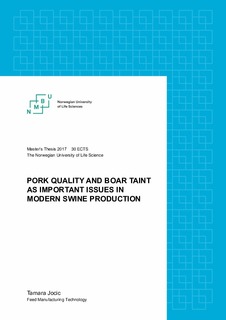| dc.description.abstract | The objective of this study was to analyze and criticize the published literature related to pork quality in male pigs, in modern swine production.
There are different types of quality and different factors that can influence the formation and assessment of quality. Meat from uncastrated males may expressed offensive odor and flavor, known as Boar taint, due to which it becomes less desirable for most of the market. Awareness about the side effects of the surgical castration is significantly increasing, while consumers are more interested in how animals are raised and produced.
To date, there are promising results from several modern on-line technologies, for boar taint detection at slaughterhouse, which are under development regarding cost efficiency, simplicity and analysis time. The sorting of boar carcasses is still based on the olfactory assessment of the animals` backfat. None of suggested alternatives for surgical castration guarantees the entire elimination of boar taint. However, further research is needed to establish a harmonized system, as a combination of different, currently available methods that would deal with the boar taint issue. Moreover, there is not yet any accepted official reference method available for the analysis of skatole and androstenone. This makes the difficulty in comparing the results between laboratories and different studies. Therewith, it is difficult to develop a harmonized system for entire elimination of boar taint. Within each European country, the percentage of carcasses with high boar taint levels and the results from consumers acceptance studies could be useful while developing an official reference method for skatole and androstenone analysis. It was encouraging to see that there is a market for tainted meat lovers which could be bigger if consumers were more informed about boar tainted products and their benefits. | nb_NO |

